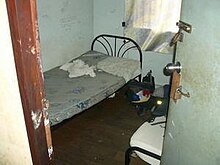Flophouse
[1] Historically, flophouses, or British "doss-houses", have been used for overnight lodging by those who needed the lowest-cost alternative to staying with others, shelters, or sleeping outside.In the past, flophouses were sometimes called lodging houses or workingmen's hotels and catered to hobos and transient workers such as seasonal railroad and agriculture workers, or migrant lumberjacks who would travel west during the summer to work and then return to an eastern or midwestern city which ran along the rail lines, such as Chicago, to stay in a flophouse during the winter.[7][8][9] Michael Adorjan, a University of Hong Kong criminology professor, has noted that "The United Nations has called cage and cubicle homes an 'insult to human dignity.'"[10] Cage hotels, a form of single-room occupancy, were common in Chicago at the turn of the 20th century; an estimated 40,000 to 60,000 people lived in them during the winter."[11]A 1958 survey by Christopher Jencks found that homeless men preferred cage hotels over shelters for reasons of privacy and security.

Doss HouseThe Flop HouseAmerican EnglishBritish Englishlodgingamenitiestransientsoffice cubiclesapartment buildingboarding housesrailroadagriculturelumberjacksmidwesternChicagoCharles AshleighLloyd MoraingentrificationBoweryManhattanNew York CitySan Franciscoco-livingCage homesHong Kongwire meshrabbit hutchesincome inequalityUniversity of Hong KongcriminologyUnited Nationsdignitysingle-room occupancycubiclescorrugated ironchicken wireChristopher Jenckssheltersdormitorieshomeless population in US citiesCapsule hotelBedspace apartmentCommon lodging-houseHostelInternet caféPunk houseStaying AliveWayback MachineLibrary of CongressEncyclopedia of ChicagoThe New York Review of BooksFiler, Randall KCity JournalNational Review Online